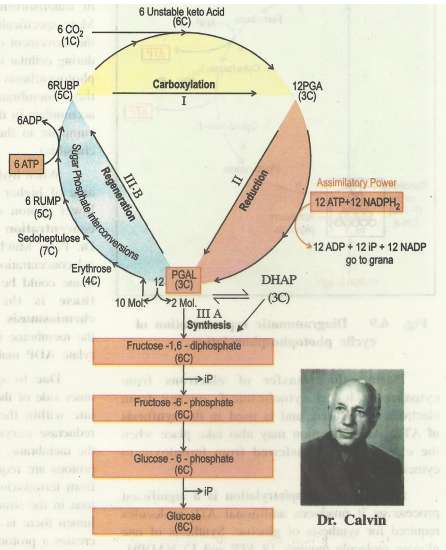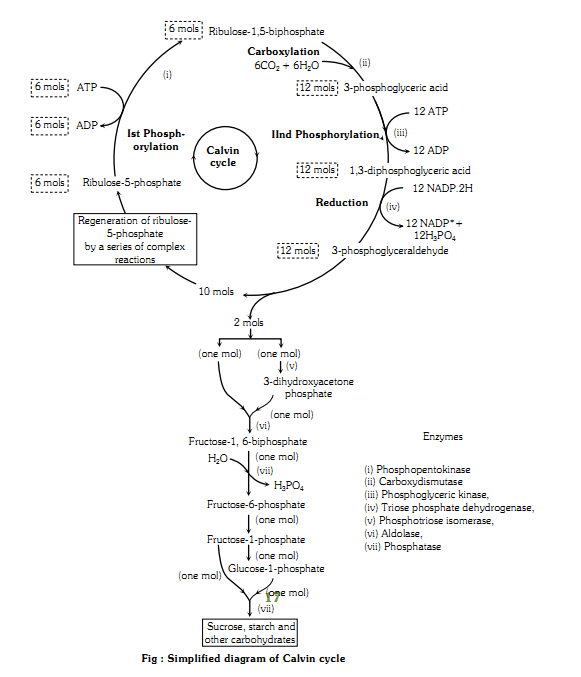LIGHT- INDEPENDENT REACTIONS
This is the second phase of photosynthesis in which CO2 is fixed or reduced to glucose.
It occurs in the stroma of chloroplast. It is independent of light (does not require direct light) hence called Dark Reaction.
The products of light reaction namely, ATP and NADPH2 are used here.
The presence of dark reaction was first established by Blackman hence also called 'Blackman's reaction'.
CO2 + 2NADPH2 + 2ATP ----------> (CH2O) + H2O + 2NADP + 2ADP + 2iP
Calvin Cycle [C3 pathway]
- The well-known plant physiologist Dr. Melvin Calvin in 1954 discovered the correct "path of carbon" in photosynthesis, i.e. sequence of biochemical reactions of CO2 fixation into glucose.
- He carried out experiments on unicellular green algae like Chlorella and Scenedesmus, and used radioactive isotope of carbon, C14, as a tracer.
- Dr. Calvin showed and experimentally proved that these biochemical reactions leading to synthesis of glucose take place in cyclic manner.
- A substance (initial acceptor) present in the stroma accepts atmospheric CO2 and forms first stable product of photosynthesis.
- This substance undergoes many changes and final product, glucose is produced in 90 seconds.
- Simultaneously, the initial accepter is regenerated so that, it can accept CO2 again and keep the process going.
The first stable product is a 3-carbon compound, hence. Dr. Calvin called it C3 cycle, or C3 pathway.
But it is more popularly known as Calvin cycle or Calvin-Benson cycle.
For this work, he was awarded a Nobel Prize in 1961, in association with his co-worker Dr. Benson.
The cycle involves following three main steps:
1. Carboxylation.
2. Reduction.
3A. Synthesis.
3B. Regeneration.
Calvin Cycle: Step 1: Carboxylation
Atmospheric CO2 is accepted by a 5-carbon compound called Ribulose 1,5 diphosphate (RUDP) or Ribulose 1-5 bisphosphate (RUBP) in presence of enzyme RUDP carboxylase or RUBP carboxylase (RUBISCO) to form a 6-carbon unstable compound.
Immediately it splits by hydrolysis into two molecules of 3-carbon compound called phosphoglyceric acid (PGA), in the presence of same enzyme.

Calvin Cycle: Step 2: Reduction: (Utilization of Assimilatory Power)
The Phosphoglyceric acid molecules are first phosphorylated by using ATP to produce 1, 3-di-phosphoglyceric acid
It is then reduced using NADPH2 to produce phospho-glyceraldehyde (PGAL) and inorganic phosphate is released.

Some part of 3-PGAL is converted into its isomer Dihydroxyacetone phosphate (DHAP) in the presence of enzyme triose -phosphate isomerase.
Calvin Cycle: Step 3A: Synthesis
- For the synthesis of one glucose molecule, six turns of Calvin cycle are required or six molecules of RUBP and six molecules of CO2 are required.
1/6 part of PGAL i.e. out of 12 molecules, 2 are used for synthesis of glucose.
2(3C) = 1(6C). One molecule of PGAL and one molecule of DHAP combine together to form one molecule of fructose 1, 6-diphosphate.

- By dephosphorylation it produces fructose-6-phosphate
- It then isomerizes into glucose-6-phosphate.
- Glucose-6-phosphate loses a phosphate group (dephosphorylation) to produce glucose.
- Glucose is either utilized or stored as starch.
During glycolysis, glucose splits into DHAP & PGAL, then PGAL gets oxidized to PGA.
Hence this part of Calvin cycle i.e. reduction and synthesis is called reverse of glycolysis or glycolytic reversal).
Calvin Cycle: Step 3B: Regeneration
RUBP gets regenerated through several biochemical reactions.
These reactions are called sugar phosphate interconversions.
All the compounds/intermediates formed are sugar phosphates, for example,
erythrose-4-phosphate (4-C), xylulose-5-phosphate (5-C), Ribose-5-phosphate (5-C), Sedoheptulose-7-phosphate (7-C) etc.
5/6 part of PGAL i.e. 10 out of 12 molecules, remaining 10 molecules are used for regeneration of 6 molecules of ribulose mono-phosphate (RUMP).
10(3C) = 6(5C).
RUMP is phosphorylated to RUBP using ATP. For regeneration of 6 RUBP, 6 ATPs are required.
Thus the initial acceptor of CO2 gets regenerated and keeps the process going! (12NADPH2 and 18 ATP are required for synthesis of one glucose molecule).


